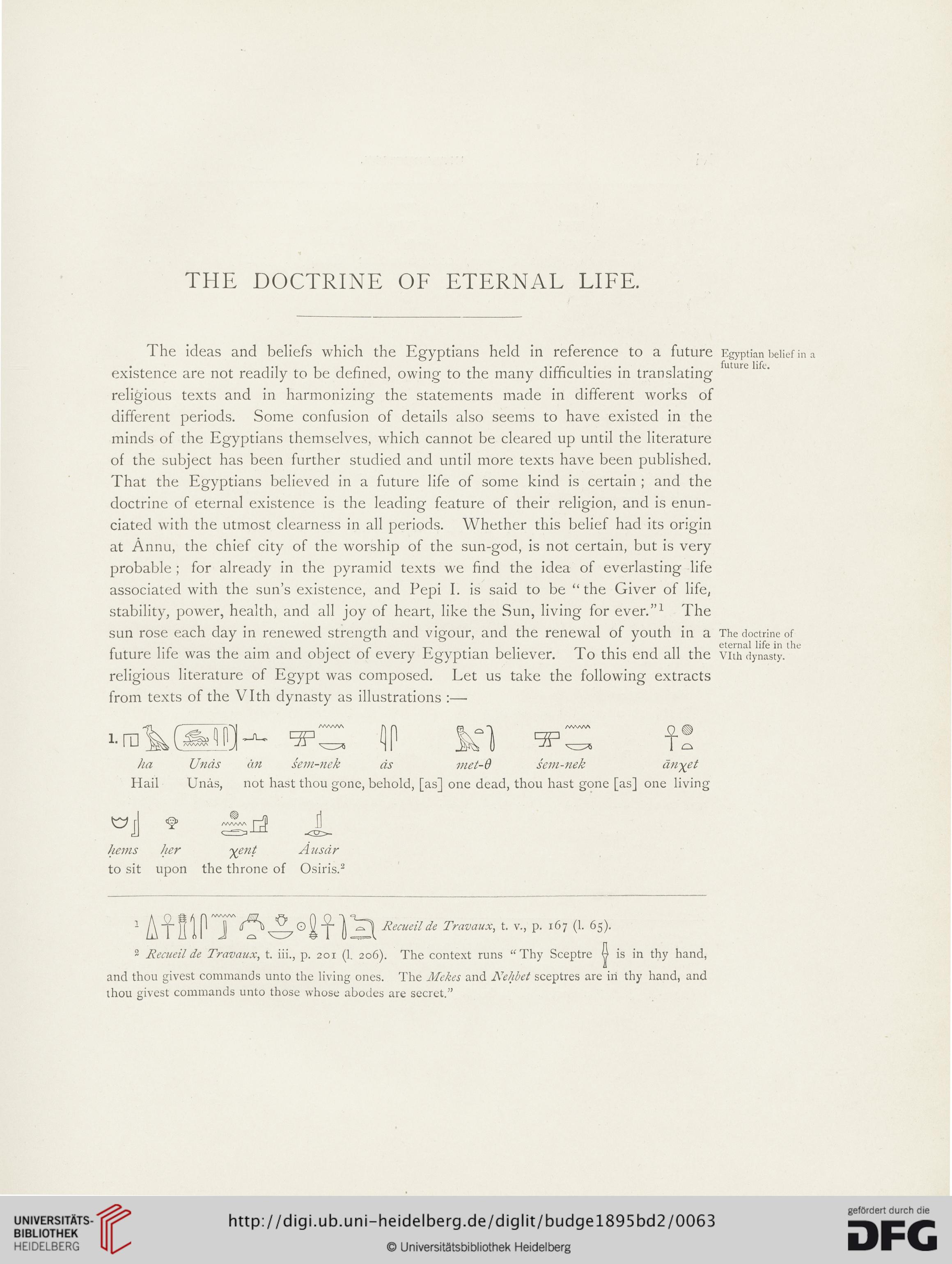THE DOCTRINE OF ETERNAL LIFE.
The ideas and beliefs which the Egyptians held in reference to a future
existence are not readily to be defined, owing to the many difficulties in translating
religious texts and in harmonizing the statements made in different works of
different periods. Some confusion of details also seems to have existed in the
minds of the Egyptians themselves, which cannot be cleared up until the literature
of the subject has been further studied and until more texts have been published.
That the Egyptians believed in a future life of some kind is certain ; and the
doctrine of eternal existence is the leading feature of their religion, and is enun-
ciated with the utmost clearness in all periods. Whether this belief had its origin
at Annu, the chief city of the worship of the sun-god, is not certain, but is very
probable ; for already in the pyramid texts we find the idea of everlasting life
associated with the sun’s existence, and Pepi L is said to be “ the Giver of life,
stability, power, health, and all joy of heart, like the Sun, living for ever.”1 The
sun rose each day in renewed strength and vigour, and the renewal of youth in a
future life was the aim. and object of every Egyptian believer. To this end all the
religious literature of Egypt was composed. Let us take the following extracts
from texts of the Vlth dynasty as illustrations :—
ha Unas
Hail Unas,
C3F.
Al1 k“] ^
f:
an sem-nek as met-0 sem-nek anyet
not hast thou gone, behold, [as] one dead, thou hast gone [as] one living
9
® r-'B
/WWNA 1
H
hems
her
yent
A nsdr
to sit
upon
the throne of
Osiris.2
1 A U | P J ® E 1 Recue^ de Truvctux, t. v., p. 167 (1. 65).
2 Recueil de Travaux, t. iii., p. 201 (1. 206). The context runs “Thy Sceptre | is in thy hand,
and thou givest commands unto the living ones. The Mekes and Nehbet sceptres are iri thy hand, and
thou givest commands unto those whose abodes are secret.”
Egyptian belief in
future life.
The doctrine of
eternal life in the
Vlth dynasty.
The ideas and beliefs which the Egyptians held in reference to a future
existence are not readily to be defined, owing to the many difficulties in translating
religious texts and in harmonizing the statements made in different works of
different periods. Some confusion of details also seems to have existed in the
minds of the Egyptians themselves, which cannot be cleared up until the literature
of the subject has been further studied and until more texts have been published.
That the Egyptians believed in a future life of some kind is certain ; and the
doctrine of eternal existence is the leading feature of their religion, and is enun-
ciated with the utmost clearness in all periods. Whether this belief had its origin
at Annu, the chief city of the worship of the sun-god, is not certain, but is very
probable ; for already in the pyramid texts we find the idea of everlasting life
associated with the sun’s existence, and Pepi L is said to be “ the Giver of life,
stability, power, health, and all joy of heart, like the Sun, living for ever.”1 The
sun rose each day in renewed strength and vigour, and the renewal of youth in a
future life was the aim. and object of every Egyptian believer. To this end all the
religious literature of Egypt was composed. Let us take the following extracts
from texts of the Vlth dynasty as illustrations :—
ha Unas
Hail Unas,
C3F.
Al1 k“] ^
f:
an sem-nek as met-0 sem-nek anyet
not hast thou gone, behold, [as] one dead, thou hast gone [as] one living
9
® r-'B
/WWNA 1
H
hems
her
yent
A nsdr
to sit
upon
the throne of
Osiris.2
1 A U | P J ® E 1 Recue^ de Truvctux, t. v., p. 167 (1. 65).
2 Recueil de Travaux, t. iii., p. 201 (1. 206). The context runs “Thy Sceptre | is in thy hand,
and thou givest commands unto the living ones. The Mekes and Nehbet sceptres are iri thy hand, and
thou givest commands unto those whose abodes are secret.”
Egyptian belief in
future life.
The doctrine of
eternal life in the
Vlth dynasty.




